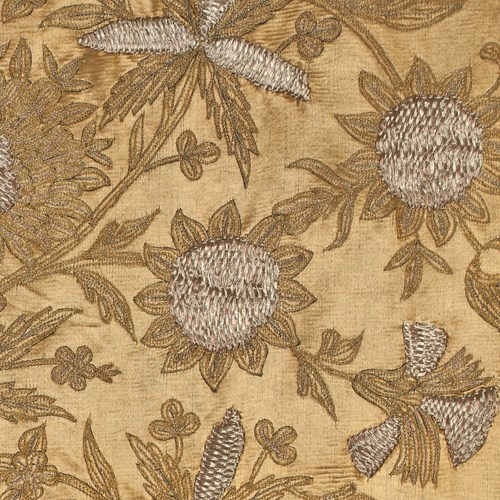Marketplace
A Large ‘Rimless’ Iznik Dish Decorated with Grapes
A Large ‘Rimless’ Iznik Dish Decorated with Grapes
Date 1550-1565
Period 1400-1600, 16th Century
Origin Turkey
Medium Ceramic decorated with underglaze polychrome
Dimension 35.8 cm (14¹/₈ inches)
This large and striking circular pottery dish is decorated with a central configuration of three hanging clusters of grapes amongst curly vines and leaves painted in cobalt blue and green on a white ground. The cavetto of the dish is painted with a blue and green frieze of undulating floral scrolls with green flower heads. The narrow border is decorated with cobalt blue half-rosettes on a blue ground. The reverse of the dish is decorated in the same manner but with a differing outer border with a geometric pattern painted in blue on a white ground. The base of the dish is simply painted with two thin blue concentric circles.
The distinctive clusters of grape decoration have been largely inspired by Ming Dynasty (1368-1644) Chinese blue-and-white porcelains which were highly prized by the Ottoman court during the 16th century. The Ottomans added green enamels to the Chinese blue-and-white palette as seen on our dish. During the second half of the 16th century, Iznik ‘grape’ dishes with everted rims of ‘wave and rock’ or ‘breaking wave’ patterns were substituted for the saucer-shaped ‘rimless grape’ dishes.
This ‘rimless’ style also emulates the Chinese ‘grape’ dishes from the 15th century. According to Raby, nearly all of the rimless grape dishes depicted continuous floral scrollwork in the cavetto whereas the grape dishes with everted rims were designed with floral sprays on the cavetto.[1] Raby states that very few of these earlier types of rimless grape dishes can be dated to the first half of the 16th century. There is a similar rimless grape dish in terms of its form and decoration, dated to circa 1550-1565, from the Lady Barlow Collection, Cambridge, and published in Raby, p. 122, fig. 189. A slightly later rimless grape dish, circa 1550-1575, in the Çinili Köşk (Tiled Kiosk), Istanbul, Accession Number 41/24, appears marginally more crowded in the floral scroll decoration seen in the cavetto in comparison to our and Lady Barlow’s dish. As a result, our dish appears to be more closely linked with the earlier family of ‘rimless’ grape dishes produced between the years 1550-1565.
An Iznik dish of nearly identical decoration is in the Freer Gallery of Art, Washington, D.C., USA, see Accession Number F1970.25. The Freer’s Iznik dish measures 32.5cm in diameter and is slightly smaller in size than ours. The outer border decoration varies slightly as the Freer piece has a zig-zag border. Another similar grape dish which has the same border decoration on the front as seen on the reverse of our dish is in the National Gallery, Prague, Czech Republic, Accession Number Vu 1549.
[1] Raby, p. 124
Stock no.: A4910
The distinctive clusters of grape decoration have been largely inspired by Ming Dynasty (1368-1644) Chinese blue-and-white porcelains which were highly prized by the Ottoman court during the 16th century. The Ottomans added green enamels to the Chinese blue-and-white palette as seen on our dish. During the second half of the 16th century, Iznik ‘grape’ dishes with everted rims of ‘wave and rock’ or ‘breaking wave’ patterns were substituted for the saucer-shaped ‘rimless grape’ dishes.
This ‘rimless’ style also emulates the Chinese ‘grape’ dishes from the 15th century. According to Raby, nearly all of the rimless grape dishes depicted continuous floral scrollwork in the cavetto whereas the grape dishes with everted rims were designed with floral sprays on the cavetto.[1] Raby states that very few of these earlier types of rimless grape dishes can be dated to the first half of the 16th century. There is a similar rimless grape dish in terms of its form and decoration, dated to circa 1550-1565, from the Lady Barlow Collection, Cambridge, and published in Raby, p. 122, fig. 189. A slightly later rimless grape dish, circa 1550-1575, in the Çinili Köşk (Tiled Kiosk), Istanbul, Accession Number 41/24, appears marginally more crowded in the floral scroll decoration seen in the cavetto in comparison to our and Lady Barlow’s dish. As a result, our dish appears to be more closely linked with the earlier family of ‘rimless’ grape dishes produced between the years 1550-1565.
An Iznik dish of nearly identical decoration is in the Freer Gallery of Art, Washington, D.C., USA, see Accession Number F1970.25. The Freer’s Iznik dish measures 32.5cm in diameter and is slightly smaller in size than ours. The outer border decoration varies slightly as the Freer piece has a zig-zag border. Another similar grape dish which has the same border decoration on the front as seen on the reverse of our dish is in the National Gallery, Prague, Czech Republic, Accession Number Vu 1549.
[1] Raby, p. 124
Stock no.: A4910
Date: 1550-1565
Period: 1400-1600, 16th Century
Origin: Turkey
Medium: Ceramic decorated with underglaze polychrome
Dimension: 35.8 cm (14¹/₈ inches)
Provenance: Private European Collection since the 19th century
Literature: Atasoy, N. and Raby, J. Iznik: The Pottery of Ottoman Turkey, Alexandria Press, London, 1989
More artworks from the Gallery




, the 10th Susuhunan of Surakarta_T637044844156194560.jpg?width=500&height=500&mode=pad&scale=both&qlt=90&format=jpg)




_T638671088209735808.jpg?width=500&height=500&mode=pad&scale=both&qlt=90&format=jpg)